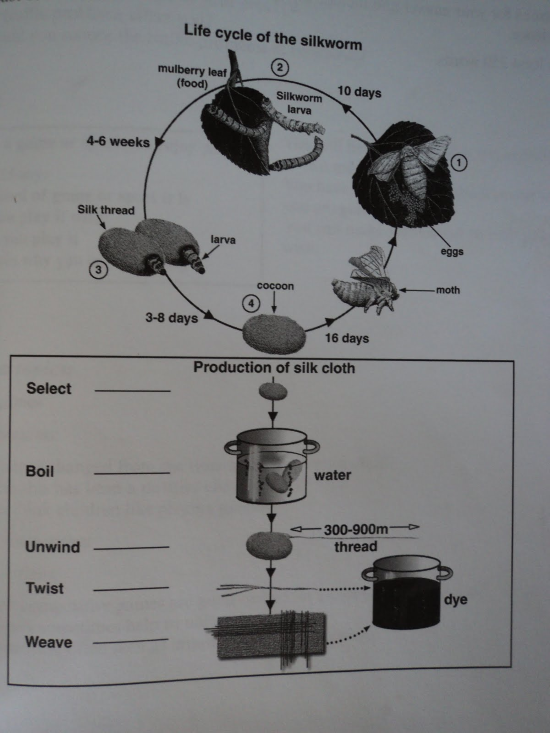The IELTS Academic Writing Task 1 challenges you to create some paragraphs of at least 150 words by looking at a specific graph, table, chart, or procedure. It can include stats or even diagrams of processes. Similarly, today we have a topic for you.
Take a look at how we have analysed the Life cycle of a silkworm diagram and written down some samples for your understanding. Read all the sections thoroughly to learn the approach.
Life Cycle of Silkworm Diagram IELTS
Let us take this topic as an example and learn how to analyse a given image to write down a good answer.
Diagram of Silkworm Life Cycle
Diagram

Life Cycle of Silkworm Diagram: Model Answer 1
The diagrams depict the silkworm’s life cycle as well as key processes in the production of silk cloth.
Ultimately, the silkworm life cycle consists of four primary phases, beginning with eggs and ending with cocoons. Furthermore, there are 4 key processes in the creation of silk cloth, beginning with the boiling process and concluding with the dying process.
The silkworm life cycle begins with eggs deposited by bees on mulberry leaves. It develops into silkworm larvae on mulberry leaves after this phase of its life cycle. In 4 to 6 weeks, it is transformed into silk thread. It is turned into cocoons after the last major stage of its life cycle, which is required to manufacture silk cloth.
Break The Paragraph
Boiling chosen cocoons in water are used in the manufacturing of silk textiles. Unwinding is the second operation that produces threads ranging from 300 to 900 mm. It is ultimately twisted, which aids in the creation of waves. Ultimately, the pattern is ready for dyeing in any shade for the final fabrication of silk garments.
Also Read:- IELTS Writing Task 1 Academic Sample Questions: Here’s Your Way to Boost-up Your IELTS Preparation
Life Cycle of Silkworm Diagram: Sample Answer 2
The diagram depicts the silkworm’s life cycle as well as the steps involved in the production of silk cloth.
A silkworm’s life cycle begins with the eggs laid by the female worm, and then after ten days, silkworm larvae are produced from these eggs. The silkworm larva consumes leaves such as mulberry leaves and finishes the second phase of its life cycle in 4 to 6 weeks. In their third phase, they form silk thread shells and stay there for 3 to 8 days before forming an oval cocoon. The cocoon phase lasts around 16 days, after which they transform into moths. The moths mature and repeat the procedure over and over again.
Break The Paragraph
The second image depicts the methods of silk textile manufacture, which include more than five phases. The silk thread shells of the silkworm are picked in the first step and then cooked in the second step. The threads are unwound after heating in water and are typically 300 to 900 metres long. These are then braided and coloured before being weaved into silks. To manufacture high-quality silks, the spinning, dying, reeling, and drying processes are repeated as needed.
Life Cycle of Silkworm Diagram: Sample Answer 3
The two images below depict the life cycle of a silkworm as well as the process of producing silk cloth.
The life cycle of a silkworm starts with eggs laid by the female worm, as shown in the first image. After about 10 days, silkworm eggs change into silkworm larvae. Then the second step begins, and larvae in this phase often ingest leaves such as mulberry leaves in order to develop.
Break The Paragraph
The food production process takes 4 to 6 weeks. At the conclusion of the second phase, the larva produces silk thread shells. The third stage occurs when silk thread shells form cocoons, which normally takes 3 to 8 days. After 16 days, cocoons change into moths in the final phase. And moths grow up and repeat the process step by step.
The complete phases of silk fabric manufacturing are five, as shown in the second image, which illustrates the creation of silk cloth from the silkworm. In the first stage, silk thread shells are chosen and cooked in boiling water. Shells are correctly unwound, and unwound shells are precisely 300 to 900m long. Threads are then twisted and coloured in dyers. Finally, the silks are woven and coloured anew.
If a high-quality silk cloth is required, the twist and dry, weave and dry operation may be repeated.
Also Read:- How to Write a Map in IELTS Writing Task 1? A Complete Guide For You
IELTS General Writing Task 1 or IELTS Academic Writing Task 1 Basic Tips
To ensure that you note the facts precisely and in the correct way, you must pause and focus on the headline construction. Sometimes, exam participants rush into writing only to discover that they misinterpreted the title. Decide what primary captions you want to basically build or summarise in that diagram, table, or other distinguishing visual that you are correlating, inferring, or seeing. Give yourself claims as to why those are the most important ones and back them up with figures from the graphic. Target to define data categories, outcomes, minimums, maximums, and structures. Design your paragraph, and try to keep an opening and at least two body paragraphs. Create a crispy introduction. You can also write your statement in the start if you don’t have time toward the end.
Conclusion
You must devote time to each section of IELTS preparation. First, you must conduct an extensive study about the test format and the strategies that can be applied. It is critical that you begin practising, and once you begin practising, it is critical that you employ these tactics when practising. For the IELTS writing portion, you must be aware of the two tasks that will be assigned to you, as well as the kind of questions that will be asked under each assignment. You can use this material to assist you to start practising the task 1 and task 2 questions.
Read more topics like this in the blog section of IELTS Ninja.
Thank you for reading!
Also Read: IELTS Writing Task 1 Academic Topics 2021: A Complete Guide to Writing Preparation










